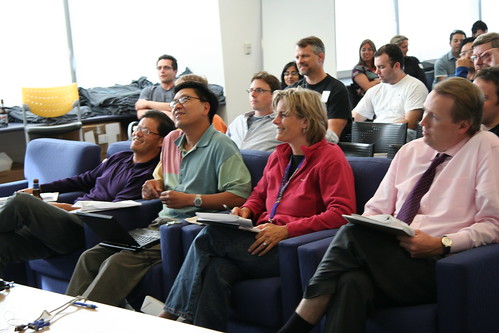Much like print and tv are becoming marketing vehicles to drive people online, the domain name for an online media service is becoming sort of an abstract utility or maybe just a brand address for media services rather than the real estate upon which the core activity occurs. The service a media vehicle provides matters more than the vehicle itself.
And this isn’t only happening in the content space. Every aspect of the media business is pointing to a services model. Here’s what the key pieces look like, in my mind:
- Data is infinitely distributable. All data…not just editorialized words. The RSS standard opened the doors for vast distribution networks, and services like Yahoo! Pipes and Feedburner figured out how to make the distribution methods meaningful. There’s an endless supply of microchunks flying around the Internet, most of them unattached to any domain or URL except as a handy reference point.
- Data can be visualized in meaningful ways. AJAX and the many freely available widget kits and javascript libraries such as YUI are rendering these microchunks in the right place at the right time in the right way for people which, again, is not always on a web site. The Internet user experience is no longer held back by the limitations of HTML and the packaging a site owner predefines for their media.
- Media is created by everyone. Whether written in long form by a reporter or researcher, captured as video by a mobile phone owner, or simply clicked by a casual web site visitor, expressions of interest are shared, measured and interpreted in many different ways. This results in a seemingly neverending stream of media flowing in and out of every corner of the digital universe.
- Distribution technologies are increasingly efficient and inexpensive. Personal media services like instant messaging, blog tools, podcasting and collaborative media services like Wikipedia, del.icio.us, Flickr, etc. are easy to use and often free. Web services and open source software enable people and companies to scale distribution and production functionality for large audiences or groups of users with negligeable costs. Most importantly, these tools enable people to be influential without ever owning a domain.
- The distance between buyer and seller is shrinking. There are more and more ways for buyers to find sellers and sellers to find buyers from search engines to recommendation tools to coupon rss feeds, etc. Distributed ad markets like Right Media are enabling marketers and service providers to negotiate both the methods and the value of a marketing message. Advertising can operate as a service, too.
After re-reading this description myself, it looks like I’ve just echoed much of the whole Web 2.0 thing yet again. That makes me think I didn’t articulate the concept properly, as I believe there’s a very different way to visualize how data get created, packaged, distributed and remixed and how the various parts of a media business can be coupled both within the organization and across the wider network. Maybe that’s Web 2.0. Maybe it’s edge economics. SOA. Whatever.
The important thing is to think of how your media business can create for yourself or leverage how others offer Marketing As A Service, Sales As A Service, Operations As A Service, in addition to your editorial and community building efforts. Here’s a quick chart of how a media business might look that hopefully gets the point across:
| Staffing Model | Source Data | Coopted Data | Distribution Services | |
| EDITORIAL | Reporters, Community Managers, Assemblers (formerly known as ‘Producers’) | Original News, Analysis, Columns | News Wires, Paid Data Feeds, Free RSS Feeds, Links, Comments, Votes, Ratings, Clicks | RSS Feeds, Content API (Read and Write) |
| MARKETING | Customer Service, Evangelists, Event Organizers | SEO, SEM, Paid Inclusion, Sponsorships, Staff Blogs | Partner Promotion, Customer Evangelist Blogs | Customer Help, Usage Policies, SLAs, Traffic/Referrals to favored partners |
| SALES | Sales Engineers, Business Development | Customer Data, On-site Inventory | Partner Inventory, OEM Partner Services | Ad Service API (Read and Write) |
We’ve seen Journalism As A Service evolve with a little more clarity, particularly recently. Mark Glaser provides a step-by-step guide on how to structure a community-driven news organization:
“Reach out to the community for bloggers, muckrakers and go-to experts. Each topic area would require more than just reacting to news. The Topic Chief would be sure to enlist as many experts as possible not only to be sources but to also be contributors, commenters, and word-of-mouth marketers. Anyone who possesses the skills that go beyond basic participation can be hired on as freelancers or even full-time staff.”
Similarly, Doc Searls’ “How To Save Newspapers” post also lays out what needs to happen on the editorial side. Here’s step #5 in his list:
“Start looking toward the best of those bloggers as potential stringers. Or at least as partners in shared job of informing the community about What’s Going On and What Matters Around Here. The blogosphere is thick with obsessives who write (often with more authority than anybody inside the paper) on topics like water quality, politics, road improvement, historical preservation, performing artisty and a zillion other topics. These people, these writers, are potentially huge resources for you. They are not competitors. The whole “bloggers vs. journalism” thing is a red herring, and a rotten one at that. There’s a symbiosis that needs to happen, and it’s barely beginning. Get in front of it, and everybody will benefit.”
There is lots of guidance for the newsroom, but all parts of a media business can become services.
For example, the ultimate in Marketing As A Service is the customer evangelist. It’s not about branded banners, as Valleywag points out,
“When paid-for banner ads lead to another site that’s supported by banner ads, you know that something’s wrong. Anyone who relies on that circular spending is asking for trouble.”
Marketing should be about enabling customer evangelists whether your customer is simply promoting your stuff for you or actually distributing and reselling it. Fred Wilson thinks of this in terms of “Superdistribution“:
“Superdistribution means turning every consumer into a distribution partner. Every person who buys a record, a movie, reads a newspaper, a book, every person who buys a Sonos or a Vespa becomes a retailer of that item. It’s word of mouth marketing, referral marketing, but with one important difference. The consumer is the retailer.”
None of this needs to happen on a single domain. The domain chain in any of these actions probably should be invisible to people, anyhow, except maybe to ground the events in trusted relationships.
Now, there are many domains that can create wonderfully useful and valuable destinations once they reach a certain critical mass. Invoking another over-used dotcom jargon word, this is what happens at the head of the long tail. And there are obviously lots of nice advantages of being in that position.
Most media companies want to be in that position and fight tooth and nail for it even if it just means being at the head of a niche curve. But instead of or maybe in addition to competing for position on the curve, most media companies need to think about how they provide relevant services outside of their domains that do something useful or valuable in meaningful ways across the entire spectrum.
Posting articles on your domain isn’t good enough any more. The constant fight for page views should be positive proof of that. There’s a bigger, deeper, longer term position out there as a critical part of a network. Sun Microsystems’ mantra “The Network is the Computer” is still meaningful in this context. What is your role if “The Network is the Media”?
Similarly, is Marshall Mcluhan’s widely adopted view that “The Medium Is The Message” still true? Or, like many have asked about the IT market, does the medium matter anymore?
If we are moving to an intention economy, then those who best enable and capture intention will win. And that doesn’t have to happen on a domain any more.
 But the problem isn’t the research, it’s the product roadmap. In order to deliver a big punch in the market and cut through the noise, you need to be bold. And big changes that get noticed by big audiences require a lot of planning and complicated scheduling. Big changes are expensive on many levels.
But the problem isn’t the research, it’s the product roadmap. In order to deliver a big punch in the market and cut through the noise, you need to be bold. And big changes that get noticed by big audiences require a lot of planning and complicated scheduling. Big changes are expensive on many levels. At the risk of invalidating everything I’ve said here by quoting a man who’s social and political beliefs go against just about everything I believe,
At the risk of invalidating everything I’ve said here by quoting a man who’s social and political beliefs go against just about everything I believe, 



